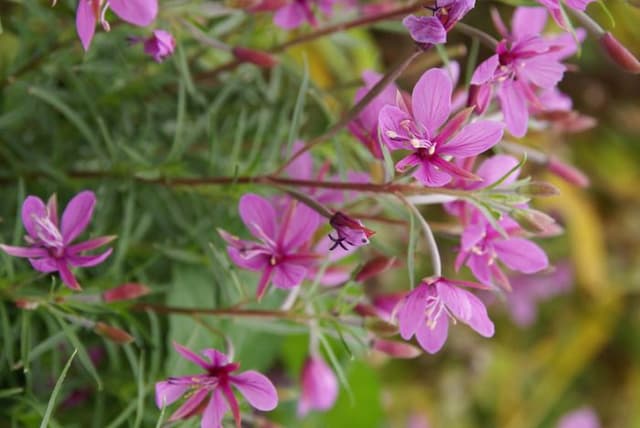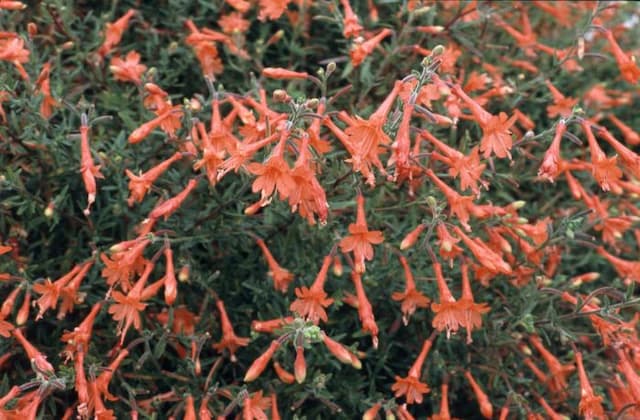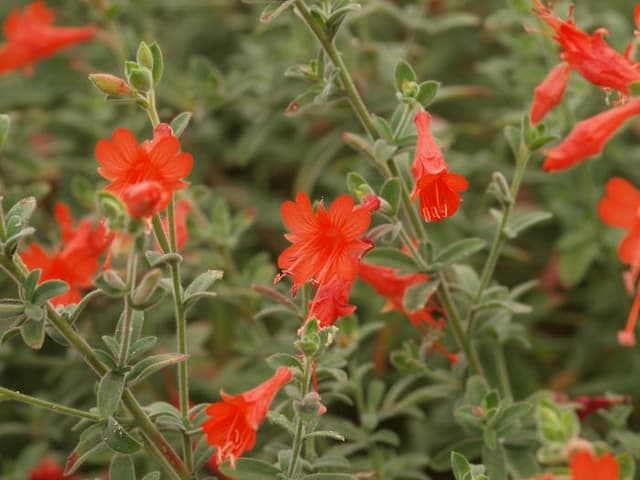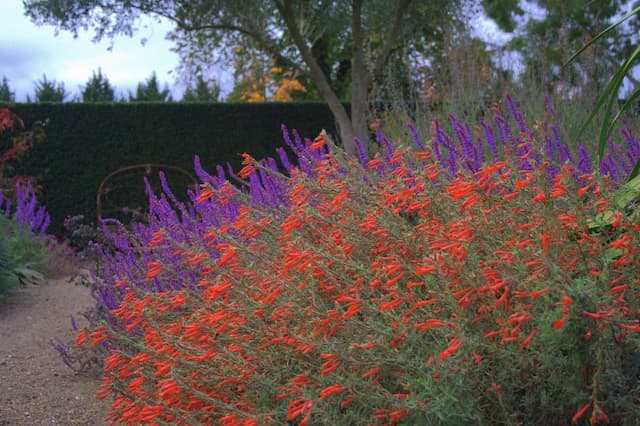Fuchsia Fuchsia 'Rufus'
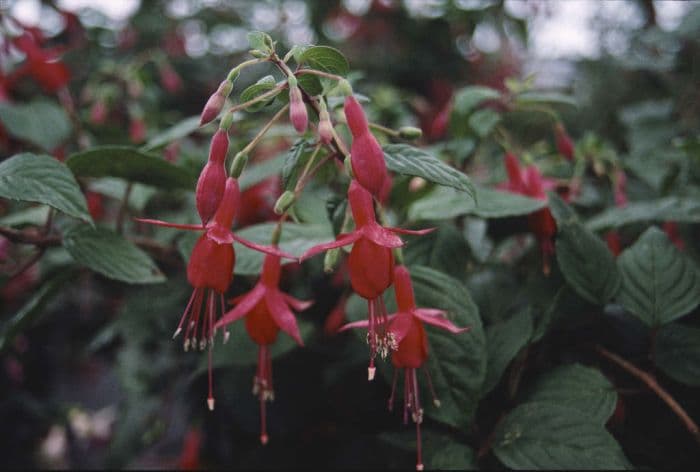
ABOUT
Fuchsia 'Rufus' is a striking and decorative plant, widely recognized for its unique and beautiful flowers. The plant showcases cascading branches that are adorned with lush green foliage. The leaves are oval-shaped with a slight point at the end and have a soft, slightly serrated edge, offering a nice texture and vibrant green color to the backdrop of the stunning flowers. These blossoms are what make the Fuchsia 'Rufus' particularly special: the flowers dangle gracefully from the branches and consist of a bold color combination. The blossoms have a two-tone appearance, with the outer part of the flower being a deep, rich red, enveloping the inner petals that are usually a contrasting shade of purple or sometimes a similar hue of red. The flowers look almost like dainty, exotic dancers, with their long, flowing skirts. They comprise a tube-like structure that flares out into a skirt of petals, with long, slender stamens that extend from the center, giving them an elegant look that attracts not only human admirers, but pollinators like hummingbirds too. The blooming period is long and prolific, with flowers gracing the plant throughout the summer months and often well into the fall, depending on the climate and care. The Fuchsia 'Rufus' is a favorite amongst gardeners and plant enthusiasts for its dramatic flowers and the vivid color they add to a garden space, whether it's grown in hanging baskets, containers, or borders. Its pendulous flowers give it a charming display that can enhance the aesthetic of a variety of garden designs. Overall, its stunning floral display and attractive foliage make it a desirable choice for those looking to add a touch of elegance and vibrant color to their surroundings.
About this plant
 Names
NamesFamily
Onagraceae
Synonyms
Ladies’ Eardrops, Fuchsia
Common names
Fuchsia 'Rufus'.
 Toxicity
ToxicityTo humans
The Fuchsia plant is generally considered non-toxic to humans. However, for some individuals, ingesting parts of the plant may cause mild gastrointestinal discomfort. It is uncommon, but if large quantities of the plant were consumed, it could potentially lead to more significant digestive upset. It is always advised to exercise caution and avoid eating ornamental plants.
To pets
The Fuchsia plant, which includes the 'Rufus' variety, is generally recognized as safe for pets. It is not known to be toxic to dogs, cats, or other domestic animals. However, it is always prudent to prevent pets from consuming plant material to avoid any potential stomach upset simply from ingesting non-food items. If a pet ingests large quantities of the plant, they may experience mild gastrointestinal irritation, but significant toxicity is not expected.
 Characteristics
CharacteristicsLife cycle
Perennials
Foliage type
Deciduous
Color of leaves
Green
Flower color
Red
Height
2 feet (0.61 meters)
Spread
3 feet (0.91 meters)
Plant type
Shrub
Hardiness zones
9
Native area
Central America South America
Benefits
 General Benefits
General Benefits- Ornamental Appeal: Adds vibrant color and visual interest to gardens with its striking red flowers.
- Attracts Pollinators: Brings beneficial insects, such as bees and hummingbirds, to the garden.
- Versatile Gardening: Suitable for growing in hanging baskets, containers, and borders, offering flexibility in garden design.
- Long Blooming: Provides a lengthy display of blossoms throughout the growing season, typically from late spring to fall.
- Shade Tolerance: Thrives in partially shaded conditions, making it suitable for garden spots that don't receive full sun.
 Medical Properties
Medical PropertiesThis plant is not used for medical purposes.
 Air-purifying Qualities
Air-purifying QualitiesThis plant is not specifically known for air purifying qualities.
 Other Uses
Other Uses- Fuchsia can be used as a natural dye, producing a range of pink and purple hues suitable for textiles and crafts.
- The plant can be incorporated into educational gardens to teach children and students about plant biology and care.
- Fuchsia, with its attractive flowers, can be used in artistic photography to add a splash of color and visual interest.
- It can serve as a living ornament during festive seasons, especially when potted and placed strategically around the house or garden.
- In eco-friendly weddings or events, Fuchsia can be used in place of traditional cut flowers for decorations to reduce waste.
- The plant may be used as a natural indicator of ecological changes, such as shifts in soil pH or humidity, due to its sensitivity to environmental conditions.
- Fuchsia can be a muse for artists and designers, inspiring patterns and motifs for fabrics, wallpaper, and other decorative items.
- It can be used in the culinary world as an edible garnish to add elegance to dishes, provided the variety used is confirmed safe for consumption.
- For hobbyists who enjoy creating terrariums, Fuchsia can add vertical interest and vibrant color to these miniature landscapes.
- Bonsai enthusiasts may use certain Fuchsia species to create delicate and ornate bonsai arrangements.
Interesting Facts
 Feng Shui
Feng ShuiFuchsia is not used in Feng Shui practice.
 Zodiac Sign Compitability
Zodiac Sign CompitabilityFuchsia is not used in astrology practice.
 Plant Symbolism
Plant Symbolism- Confiding Love: Fuchsia plants, in general, are associated with confiding love. The intricate and somewhat delicate appearance of their flowers suggests a depth and intimacy that align with expressing more profound affection.
- Taste: The fuchsia is sometimes linked to notions of taste or good judgment, perhaps due to the elegant and tasteful appearance of its blooms.
- Grace Under Pressure: With the ability to bloom in shaded conditions, Fuchsia 'Rufus' symbolizes poise and resilience even when faced with challenging situations.
- Warning: In the language of flowers, fuchsia can also represent a warning, signaling a polite decline of a suitor’s interest in Victorian times.
 Water
WaterFuchsias, including the Fuchsia 'Rufus', need to be watered regularly with enough water to keep the soil moist but not waterlogged. During the active growing season in spring and summer, watering might be necessary once or twice a week, depending on the weather conditions; aim for about 1-2 gallons per week. Ensure the top inch of soil dries out slightly before the next watering to avoid overwatering. In winter, reduce watering but do not let the soil completely dry out.
 Light
LightFor Fuchsia 'Rufus', the best light conditions are bright but indirect light. A spot that receives morning sunlight and afternoon shade would be ideal. They can also thrive under dappled sunlight throughout the day, ensuring they are protected from the intense midday sun which can scorch their leaves.
 Temperature
TemperatureFuchsias prefer a cool climate with temperatures ranging between 55-75°F for ideal growth. They can survive temperatures down to around 40°F but should be protected from frost. High temperatures above 76°F can stress the plant and should be avoided.
 Pruning
PruningPruning Fuchsia 'Rufus' is important to promote bushy growth and to remove dead or diseased wood. The best time to prune is in late winter or early spring before new growth begins. Lightly prune throughout the growing season to shape the plant and encourage more flowers. Major pruning should be done annually.
 Cleaning
CleaningAs needed
 Soil
SoilThe ideal soil mix for a Fuchsia 'Rufus', commonly known as Hardy Fuchsia, should be well-draining yet hold some moisture, with a good mix of loam, peat, and sand in equal parts. The pH should be mildly acidic, around 6 to 7.
 Repotting
RepottingHardy Fuchsias should be repotted every two to three years, or when the root system outgrows the current container, to refresh the soil and allow more room for growth.
 Humidity & Misting
Humidity & MistingHardy Fuchsias thrive best in moderate to high humidity levels, ideally between 60-70%, which supports their lush growth without encouraging disease.
 Suitable locations
Suitable locationsIndoor
Place in bright, indirect light and maintain high humidity.
Outdoor
Ensure partial shade, shelter from wind, and moist soil.
Hardiness zone
6-9 USDA
 Life cycle
Life cycleFuchsia 'Rufus', commonly known as simply Fuchsia, begins its life cycle with seed germination, which requires warm and moist conditions. Once germinated, the seedling stage involves the development of a few leaves and a root system. As the plant enters the vegetative stage, it grows rapidly, producing a bushy structure with numerous branches and leaves. Flowering, a critical stage in the Fuchsia's life cycle, can occur repeatedly throughout the growing season, where the plant produces its characteristic exotic-looking flowers. Following pollination, usually by hummingbirds or insects, the flowers develop into oval-shaped berries containing seeds, completing the reproductive cycle. In colder climates, Fuchsia 'Rufus' may enter a period of dormancy during winter, where it ceases growth until favorable conditions return in spring.
 Propogation
PropogationPropogation time
Spring-Early Summer
Fuchsia 'Rufus', commonly referred to as Lady's Eardrops, can be effectively propagated through softwood cuttings. This method is extremely popular due to its simplicity and high success rate. The best time to take cuttings is in spring to early summer when plants are actively growing. Cut a 3- to 5-inch (7.6 to 12.7 cm) portion of young, healthy growth, making sure to remove the bottom leaves. Dip the cut end in rooting hormone to encourage root development and plant it in a well-draining soil mix. Keep the soil moist and place the cutting in a warm area with indirect sunlight. Roots usually form within 3 to 4 weeks, after which the new Fuchsia 'Rufus' can be transplanted into a larger pot or directly into the garden.
